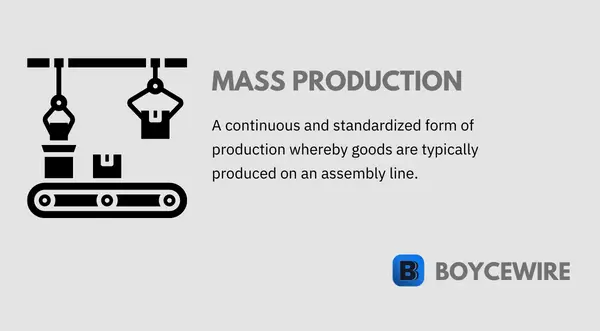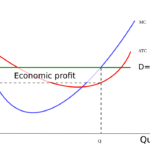Mass Production: Definition, Pros, Cons & Examples

What is Mass Production
Mass production is the continuous production of standardized products, usually along an assembly line. It involves making products in large quantities so that businesses can provide them to the masses. This type of production maintains a consistent quality of output, but comes at the cost of a lack of flexibility.
Mass production involves making the same product over and over again according to the same specification. It was originally designed by Henry Ford in the late 1910s and 1920s, when he used it to manufacture his vehicles for the Ford Motor Company. Through the use of the division of labor, Henry Ford set up an assembly line to produce the Ford Model T.
Each employee had a specific task. One would fix on the doors, another would fix on the wheels, and another to fix on the windows. As each individual only had one set and specific task, they became extremely proficient at it. By working together as a collective, rather than individuals, Ford was able to rapidly expand its productive output. Instead of focusing on manufacturing the whole car – employees were more effectively deployed in specific asks.
Key Points
- Mass production is where goods and manufactured in large quantities in a standard format.
- Henry Ford is commonly associated with mass production following his adoption of the assembly line.
- Whilst mass production can be inflexible, it is the most efficient form of production.
The issue with mass production was that it became a very repetitive and mundane, as employees were asked to do the same thing over and over again. Ford identified this as an issue and rewarded his employees with wages that far exceeded the industry average. This was only achievable due to the vast efficiencies that mass production achieved.
Whilst efficiency and output increased, there was one catch – adaptability. With the assembly line running at speeds never seen before, it had to standardize production. Henry Ford demonstrated this succinctly by stating that consumers could ‘have any color as long as it was black’. This was because mass production requires standardization in order to benefit from increases in efficiency. In turn, this makes the product more affordable and therefore available to the masses.
Characteristics of Mass Production

Mass production has become a staple for businesses across the world today and is used in industries ranging from manufacturing to canned foods to gaming. However, what are the characteristics of mass production? And how does it differ from other forms of production? Let us look at its characteristics below:
Division of Labor
Mass production commonly uses machinery in its production process – each with a specific function. For example, canned soup requires one machine to make the soup, another to fill the can up, and another to close it. Yet some industries still require human labor – such as motor vehicle manufacturing.
Motor vehicles are often produced by mass production and require hundreds of workers who each have a specific task. One may fix the window, another to fix the wheels, and another the steering. Each takes a time to master and by assigning one person for each job, they are able to produce a car at a far faster rate than one individual doing a car at a time.
Smooth Production Flow
Mass production has to have a smooth production process. This means that as the product is made, it is moved on to the next station in good time. For example, the canned foods go through a number of stages.
First, the food needs to be manufactured. Second of all, the cans need to be supplied. These are then put onto an assembly line which flows them along onto a hopper which would dispense the food. The can would then be moved along onto another machine which would enclose the can. This then moves onto another section which labs the can. Finally, the finished can is then moved onto a pallet or crate where it will be dispensed to its final location.
Standardized
Mass production is a very standardized process. In order to produce in such large quantities, the goods have to be the same. If a firm would want to change the goods output, it would require significant levels of alterations and complicate the process. This would add time and cost money – particularly from the amount of lost potential output.
Such a large output can only be achieved when the process does not deviate. That way employees and the machines they use are able to consistently produce the same goods. By altering the process, employees may slow down and it will take time to alter the machines. This costs both time and money, which is not practical for mass products.
Undefined Demand
It is easy to get confused between batch production and mass production. Whilst batch production is set to meet a specific level of demand, mass production produces to a level by which it is most efficient. By stop starting the process in mass production – additional costs are created and can significantly affect the quality of output.
Instead, under mass production, goods are produced in a quantity by which the factory or firm is able to. If the goods are unable to sell, then the firm may reduce the price to the cost of production. However, by producing on mass, the final price is made cheaper in the first place.
High Startup Costs
Mass production requires a high number of resources to get started. A firm will require all the components to set up a streamlined process. It will most likely need a factory and machinery, as well as trained personnel – all of which takes up significant levels of capital.
Mass Production Examples

If you look around you, most of the goods you see are massed produced. This is because it is the most efficient way to make them affordable to the masses. Goods such as hand-crafted ceramic bowls, or a hand-crafted desk take longer to product because they require a significant level of skill and the task cannot be divided. These are more expensive than their mass-produced counterparts, but is also why they are often more sought after – due to their rarity. However, mass production has made it affordable to buy a wide number of goods. Such examples include:
Motor Vehicles
Before Henry Ford introduced the assembly line and his mass production of the Model T, motor vehicles were only available to the rich. Cars were so expensive due to the inefficient nature of its production, so the working and middle class could not afford one.
Since Ford’s revolutionary invention, motor vehicles are now mass produced all across the world. Each employee has a different task. One may put on the door, whilst another assembles the steering wheel, and another the tires.
Canned Foods
Most canned foods these days are manufactured using mass production. The production process is largely machine operated and flows through a conveyor belt system which fills and encloses the foods. For example, baked beans flow constantly through a number of stages. First of all, the beans are rehydrated and then inserted into the cans. These then go onto another stage where the spices and tomato sauce is added. They are then cooked, sealed, and then wrapped in the branded paper.
Games Consoles
Video games consoles such as the PlayStation and Xbox are examples of mass production. Both Sony and Microsoft produce these in Asia using a very automated process with little involvement in human labor. They are usually produced in large quantities in order to make them accessible to the everyday consumer. Even at existing prices, the two firms make little, if any profit.
Without mass production, games consoles would be too expensive for most of us to afford. It is only because the two firms produce in large quantities, that it can benefit for lower long-run unit costs.
Mobile Phones
Not only are mobile phones mass produced, but also their parts. For example, most modern smart phones source its inputs from all across the world – ranging from batteries in Taiwan, cameras in Japan, and its cases from China. These are all mass produced across the world and largely manufactured in China.
In Chinese factories, the parts of the iPhone are assembled together. Unlike most other mass-produced products, this is done largely by hand – due to the delicate nature of the assembly. However, this is done in a similar fashion as the Ford assembly line. Each individual has a specific task and the half-assembled product is passed along for everyone to play their part.
According to the New York Times: “There are 94 production lines at the Zhengzhou manufacturing site, and it takes about 400 steps to assemble the iPhone, including polishing, soldering, drilling and fitting screws. The facility can produce 500,000 iPhones a day, or roughly 350 a minute.”
Mass Production Advantages

Mass production is widely used across the world and through a large number of industries. It’s popularity is not without merit, with a number of advantages demonstrating why firms employ it:
1. Efficiency
Mass production is the most efficient form of production. This is because the process is segmented into its components. That way the process never stops. It can continuously flow down an assembly line with each stage being completed by a different machine or worker. This comes at the cost of flexibility, but is a price worth paying for its significant cost reductions.
2. Fewer Workers
Depending on the type of goods being produced, fewer employees are needed. This leads into the previous efficiency described. By needing fewer employees, the firm has fewer overhead costs. That means it can produce at a lower unit cost and therefore provide it to the mass population at a lower price.
3. Lower Costs
Lower costs are achieved through a number of reasons. First of all, fewer workers are needed. Second of all, there is an increased efficiency of production. And third of all, there is reduced waste. As the production process is streamlined and to a certain extent, automated, there is a reduced level of waste.
For example, other forms of production may require an individual to produce the whole final good. If the individual is not highly proficient, they may make the odd mistake and damage the good. However, with mass production, the employee is more skilled as they can focus on one specific task – which can reduce waste and sunk costs through damaged goods.
4. Precision
With mass production, everything is standardized – from the product to the machines. Everything is repeated over and over again in the exact same way. This fine-tuned machine means that each product has the same quality as the last. As it runs through the assembly line, each relay point has a specific task to do. And because the task is so specific, the individual or machine is able to produce with great precision.
5. Fast Production
Perhaps one of the biggest advantages to a manufacturer is the fast production rate of mass production. It is the fastest of all production processes, with conveying systems advancing beyond imagination. They are now able to identify products and re-direct them to the next stage without any need for human intervention.
Mass Production Disadvantages

Whilst mass production is an extremely popular process among manufacturers – it is not always the best for different industries. There are a number of disadvantages that mass production presents which makes it inappropriate for some types of businesses. Such examples include:
1. High Start-up Costs
Starting a mass production business requires huge start-up costs such as that for the factory, land, and machinery. These costs alone will require millions just to get going. Small startup businesses will find it difficult to amass this capital and compete. In turn, they must use different production processes at a higher cost – which makes it difficult to compete.
2. Disengaged Workforce
Many industries that adopt mass production mainly use machines. However, there are industries that require the use of high levels of labor. For example, the iPhone requires hundreds of workers to assemble it together. The issue with such is that such work can become mundane. As each worker has a very specific task, they are assigned to repeat it over and over again. Whilst this can increase efficiency in the short-term, it can lead to de-motivated employees in the long-term.
3. Inflexible
Consumer demand can change over time and when the market changes, firms that engage in mass production will find it expensive and time consuming to change. This is particularly noticeable in fashion which relies on constantly changing styles. Another example can be seen in the food industry whereby food can go to waste if too much is produced. There can be seasonal fluctuations which can make it difficult to determine demand. So when food is perishable, the cost benefits achieved by mass production may not be worth the sunk costs of perished goods.
FAQs
Some common examples of mass production include motor vehicles, mobile phones, video games consoles, and canned foods.
Mass production is important as it increases the efficiency of production which reduces the unit price. In turn, the producer can charge lower prices, thereby making it available to the masses.
Mass production is good in the sense that it increases efficiency and reduces prices for the consumer. However, mass production can destroy jobs in industries – particularly when it is driven being technological innovation.
About Paul
Paul Boyce is an economics editor with over 10 years experience in the industry. Currently working as a consultant within the financial services sector, Paul is the CEO and chief editor of BoyceWire. He has written publications for FEE, the Mises Institute, and many others.

Further Reading
 Exchange Rate: Definition, Causes, Effects & Types - An exchange rate is the value by which two currencies are swapped with each other.
Exchange Rate: Definition, Causes, Effects & Types - An exchange rate is the value by which two currencies are swapped with each other.  Marginal Revenue: How to Calculate with Formula & Example - Marginal Revenue is the money a firm makes for each additional sale. So if a baker sells an additional loaf…
Marginal Revenue: How to Calculate with Formula & Example - Marginal Revenue is the money a firm makes for each additional sale. So if a baker sells an additional loaf…  Transfer Pricing Definition and Examples - Transfer pricing is the practice of setting a price for goods or services exchanged between related parties, aimed at achieving…
Transfer Pricing Definition and Examples - Transfer pricing is the practice of setting a price for goods or services exchanged between related parties, aimed at achieving… 